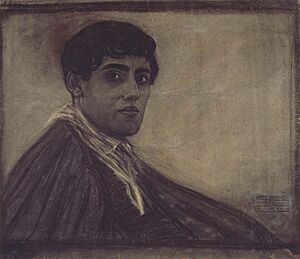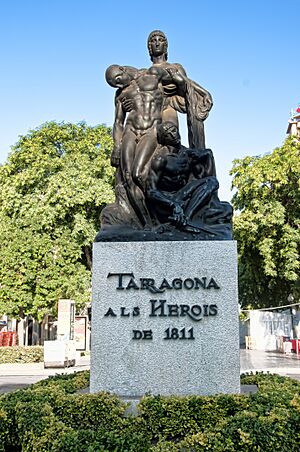Julio Antonio facts for kids
Antonio Rodríguez Hernández, known as Julio Antonio, was an important Spanish sculptor. He was born on February 6, 1889, in Mora de Ebro, and sadly passed away on February 15, 1919, in Madrid, when he was only 30 years old.
About Julio Antonio's Life
Julio Antonio began his journey in art by studying sculpture in Tarragona. Later, he learned even more by working in the workshops of Fèlix Ferrer i Galceran in Barcelona. When his family moved to Murcia, he created his very first original sculpture. He later decided to destroy this early work.
When Julio Antonio turned 18, he received a special scholarship from the Tarragona local government. This allowed him to move to Madrid. There, he worked in the studios of Miguel Blay, who was one of Spain's most famous sculptors at the time. Even though he learned a lot from Blay, Julio Antonio wanted to explore more. He decided to travel across Spain with his friend, the painter Miquel Viladrich Vila. After their travels, they opened their own art studio together.
In 1908, Julio Antonio created a very important sculpture called "María, la gitana" (Maria, the Gypsy). This artwork was special because it showed his unique artistic style. It was different from the popular art styles of that time. Besides sculpting, he also worked as an illustrator. He drew pictures for books by writers like Antonio de Hoyos y Vinent and Ramón Gómez de la Serna.
Julio Antonio's art was starting to become very popular. However, he sadly died at the young age of 30 due to a serious illness. His most famous work is a large monument dedicated to the heroes who defended Tarragona during the Peninsular War. He worked on this monument from 1910 until shortly before he passed away. Because of money problems and disagreements about where to place it, the monument was not officially opened until 1931. Another well-known sculpture he created was a monument for the Lemonier family. It was made to honor their eldest son, who passed away at age 11. This monument was never placed at the tomb and can now be seen in the Museo de Arte Moderno de Tarragona.
In November 2018, just before the 100th anniversary of his death, Julio Antonio's remains and those of his mother were moved. They were reburied in the cemetery in Mora de Ebro, his hometown.
See also
 In Spanish: Julio Antonio para niños
In Spanish: Julio Antonio para niños



